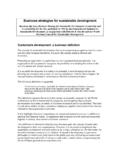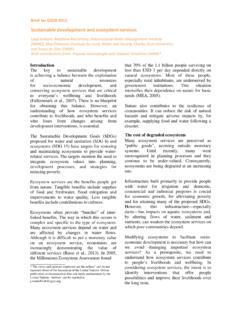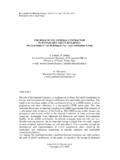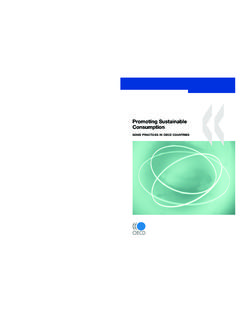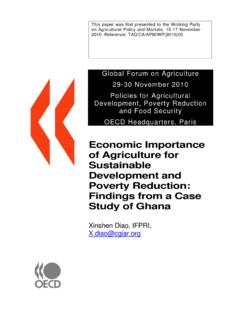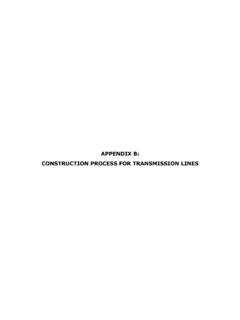Transcription of Sustainable Land Development Today Phosphorus …
1 Phosphorus Reduction in Stormwater Runoff Contributed by Britt Faucette, , CPESC, LEED AP, and Buzz FerverMonday, 11 January 2010 While P is essential to terrestrial plant growth, it is often a pollutant in fresh-water (P) is a nonmetallic chemical element found in the environment that is an essential nutrient to plants in land -based ecosystems. While P is essential to terrestrial plant growth, it is often a pollutant in fresh-water ecosystems. Asthis nutrient is typically the limiting nutrient to plant growth in fresh water systems (as nitrogen is to plantson land -based ecosystems) a small amount of P loading to a water body can elicit a rapid-growth response by P is not toxic to humans or aquatic organisms, once algae blooms occur in an aquatic ecosystem, the microbialdecomposition of the algae causes aquatic microbes to utilize a higher percentage of the dissolved oxygen in water,thereby causing fish and other aquatic organisms to suffocate and ultimately die, often in large numbers.
2 This process iscalled eutrophication. Additionally, algae growth can blanket the surface of a water body, thereby reducing sunlightpenetration through the water, resulting in reduction of photosynthesis to aquatic plants under the surface. These aquaticplants are often habitat and/or food source for other aquatic organisms in the food web whereby reductions can lead tomortality of certain aquatic organisms or even whole trophic levels. Phosphorus enters surface waters typically through non-point source stormwater runoff. It is either attached to sedimentparticles (particulate or sediment-P) or free-floating in the runoff water solution (dissolved or soluble-P). Sediment-Prunoff is typically higher where soils are disturbed, such as construction sites; while soluble-P is higher where landsurfaces have been recently fertilized or where stormwater volumes are high due to prevalent impervious surfaces in thewatershed such as parking lots, highways, and roof tops. Reducing phosphorous loads from runoff can be doneby source reduction, reducing runoff volume (through infiltration or containment practices such as bioretention,engineered soils, and green roofs), or filtration (by physical means for sediment-P and chemical means for soluble-P).
3 By the NumbersThe total Phosphorus concentration generally used for wastewater-treatment plant discharge limits is 5 mg L-1 (5 ppm),while typical urban stormwater-runoff concentration is approximately mg L-1 ( ppm). The critical concentration oftotal P (sediment-P + soluble P) in streams at which eutrophication is triggered is mg L-1 ( ppm), and mg L-1 ( ppm) for soluble P (Brady and Weil, 1996). Soluble P entering surface water is of particular concern because it isoften available to aquatic plants for immediate uptake, leading to increased risk of eutrophication, while sediment-P is notreadily available for plant uptake (but can become available over time). It is estimated that the total annual loss ofphosphorus, nitrogen, and potassium due to soil erosion in the US is over 38 million Mg (42 million tons), and the annualcost to society is over $27 billion per year (Brady and Weil, 1996). In a 1998 water-quality assessment conducted for the US EPA, 35 percent of US streams sampled were found to beseverely impaired while nutrient loading was the leading cause for 30 percent of those listed (US EPA 2000).
4 Streamsdesignated for total maximum daily load (TMDL) compliance [Section 303(d) of the US Clean Water Act] for phosphoruspollution have become increasingly common in recent years. Over 5600 water bodies have been labeled as nutrientimpaired and over 3500 have been designated as TMDL water bodies or segments for nutrients since 1995 (US EPA,2007). While erosion and sediment control best management practices (BMP) may reduce sediment-P, they do little toreduce soluble-P in stormwater runoff. Additionally, when soil becomes detached, sediment-P can quickly becomedesorbed, thereby transforming into soluble-P (Westermann et al. 2001). Where sedimentation is minimal, due toeffective erosion control and/or permanently stabilized land surfaces, soluble P can be more than 80 percent of total P(Berg and Carter 1980). In order to improve receiving water quality, and in particular to meet TMDL requirements forphosphorus, BMPs need to reduce soluble-P loading to streams. Soluble-P is more reactive, or bioavailable, relative tosediment-P to aquatic plants; therefore, it is more likely to cause algae blooms and eutrophic conditions contributing tothe degradation of our nation s surface water SolutionsCompost Filter SocksCompost filter socks provide a physical means to filter sediment-P from stormwater, while the organic matter and humusfraction of the technology adds a chemical filtration component by chemically adsorbing soluble P ions in to research conducted at the USDA Agricultural Research Service (USDA ARS) with FiltrexxInternational s FilterSoxx , this technology removes 65 percent of total P and 27 percent of soluble P fromstormwater runoff on disturbed or bare soils.
5 By adding PhosLoxx to the technology, they reported that onfertilized soils, soluble-P removal efficiency from runoff increased to 92 percent. Experimental conditions included runoff-sediment concentrations of 60,000 mg/L, runoff total P concentration of 82 mg/L, soluble P concentration of 37 mg/L, andconstant exposure to 30 minutes of simulated rainfall-runoff (Faucette et al, 2008). Compost -BlanketsCompost blankets, often referred to as compost erosion-control blankets or compost stormwater blankets, reduce Ploading through site stormwater runoff volume reduction and because plant nutrients are organic (instead of mineral orSustainable land Development by Joomla!Generated: 8 March, 2011, 18:33inorganic) - a form less mobile under storm runoff conditions relative to fertilizers typically used in traditional seeding andhydromulching applications. According to research conducted at the University of Georgia (UGA) these composttechnologies can reduce total P and soluble P loading in stormwater runoff by over 80 percent relative to hydroseed andhydromulch used in seeding and vegetation establishment applications (Faucette et al, 2005).
6 Case Study: Lake Simcoe, Ontario, CanadaThe fifth largest lake in Southern Ontario, Canada, with a surface area of 720 km2, Lake Simcoe has elevated levels ofphosphorus due to point and non-point source pollution from stormwater runoff. The Ontario Ministry of the Environmenthas designated the lake as the future model in watershed protection and receiving water Phosphorus reduction. The lakeis home to approximately 400,000 residents and has experienced rapid Development and urbanization in recent , the lake receives an estimated 53 to 67 tons/yr of Phosphorus . The goal is to reduce P loading by 25 percentto improve end-of-summer dissolved oxygen levels in the lake using appropriate site design and BMPs. Under newregulations to improve and protect the lake, the provincial and federal governments are working together with a varietystakeholders. A consortium, comprised of the Ontario Ministry of the Environment, Ontario Centers of Excellence,Environment Canada, Lake Simcoe Region Conservation Authority, Toronto and Region Conservation Authority,University of Guelph, Greenland International Consulting, the Cortel Group, Filtrexx Canada, and Filtrexx International, iscollaborating on a research project to improve stormwater management practices for urban Development sites.
7 Compoststormwater BMPs, with and without Phosphorus -reducing agents, will be designed and installed for construction and post-construction runoff Phosphorus reduction. A model Development site will employ automated stormwater samplers tomonitor and allow evaluation of the design and installation of these BMPs and the potential benefit they may provide tolake water Study: Montpelier High School, VermontThe school recently increased the size of a one-acre, gravel parking lot to a paved parking lot just under two acres. TomSabo s Senior Biology Class and the school s Earth Group student organization were concerned that thenew parking lot would substantially increase Phosphorus loading to the Winooski River, which drains directly to LakeChamplain. Lake Champlain has been well publicized as having elevated Phosphorus levels due to urbanization andincreases in impervious surfaces in surrounding watersheds. The biology class was in charge of designing, specifyingBMPs, and monitoring stormwater quality to control the anticipated elevation in runoff and Phosphorus the new parkingstructure would generate.
8 The class helped design and specify a Filtrexx bioretention and filtration cell system to captureand filter runoff from approximately 90 percent of the average annual rainfall using historical rainfall data. Stormwaterquality sampling and analysis from the green infrastructure system will begin this spring. With financial support from SeaGrant and University of Vermont Cooperative Extension, and in-kind support from Vermont Youth Conservation Corps,Agrisource, Certified Erosion Control of New Hampshire, New Moon Nursery, and Filtrexx International Design ServicesDivision this project has provided a hands on learning experience for college-bound science students and has helpedprotect the water quality of Lake Champlain using green infrastructure and low-impact Development principles. Case Study: Bonnaroo Music and Arts Festival, TennesseeAs one of the largest music festivals in the world, this joint venture between AC Entertainment and Superfly Productionsattracts approximately 80,000 fans for four days to the 700 acre farm and venue where the festival is held.
9 Its managersare very committed to event environmental sustainability and have incorporated many Sustainable practices, including,measures to conserve energy, carbon offsets through the Chicago Climate Exchange, preference for organic foods andcatering, products and services provided by local businesses, recycling, and on-site composting. As part of thecommitment to sustainability, managers contracted Clean Vibes, a management company that specializes in reducingthe ecological footprint of festivals and events, to help set up (among other things) a composting facility to recycle festivalorganic wastes. Filtrexx International Design Services was contracted to design a filtration cell to capture and treatstormwater runoff from the composting operation to reduce Phosphorus and other potential runoff pollutants from leavingthe site and entering nearby surface waters. Earthscapes of Chattanooga, Tennessee installed the filtration cell. Phosphorus in stormwater runoff is one of the leading causes of surface water pollution in the United States.
10 Stormwaterreduction and pollution prevention using Sustainable management practices and natural design principles is not only thefuture of this industry, but a win-win for all of us. SLDTA bout the authors: Dr. Britt Faucette is director of Research and Technical Services for Filtrexx International and can becontacted at: 678 592 7094, or Ferver is a Design Ecologist with Filtrexx International and can be reached at: 440 926 2607 Sustainable land Development by Joomla!Generated: 8 March, 2011, 18:33










